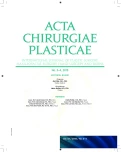A-09 Plasmatherapy in chronic skin defects – results of a prospective study
Authors:
D. Stehlik; B. Zálešák; I. Hatalová
Authors‘ workplace:
Department of Plastic and Aesthetic Surgery, University Hospital and Medical Faculty of Palacky University in Olomouc, Czech republic
Published in:
ACTA CHIRURGIAE PLASTICAE, 57, 3-4, 2015, pp. 59
Category:
Selected abstracts from the 36th national congress of the czech society plastic surgery with international participation
This presentation shows final results of the clinical utilization of platelet growth factors or PRP (Platelet Rich Plasma) in local therapy of chronic defects or preparation of these defects before a subsequent surgical procedure. This presentation of our unit is supposed to confirm or rule out therapeutic efficiency of locally administered “enriched” own blood plasma on the defects to start natural reparative processes where other conservative methods failed and there is a plan for definite treatment of the defect with a skin graft or flap. This is plasma that was prepared from own blood and it contains concentrated growth platelet factors without their further selection. It is prepared by centrifugation and it is administered under aseptic conditions to the defects, mainly on the lower limbs. Our study includes most frequently patients with calf ulcers, defects in patients with diabetic foot syndrome or defects in critical limb ischemia, in whom previous conservative therapy failed or there was no indication of invasive surgical therapy (vascular procedures, etc.). We present a group of 68 patients with the aforementioned diagnoses, to whom we administered PRP therapy to start treatment of a chronic defect, where repeated conservative therapy failed and patients were previously treated without significant effect for at least 12 months and longer. The goal was mainly initiation of granulation tissue growth at the bed of the defect, reduction of pain and remodeling of scar edges and base. The goal was not complete primary spontaneous healing of the defects, but preparation before subsequent surgical closure of the defect (most frequently skin grafts or flaps). For comparison of the effectiveness of the method, we present the results of a control group of patients who underwent treatment with moist wound healing only. This group had similar spectrum of defect etiology.
Labels
Plastic surgery Orthopaedics Burns medicine TraumatologyArticle was published in
Acta chirurgiae plasticae

2015 Issue 3-4
Most read in this issue
- 36th NATIONAL CONGRESS OF THE CZECH SOCIETY OF PLASTIC SURGERY WITH INTERNATIONAL PARTICIPATION
-
ZORA JANŽEKOVIČ
(September 30, 1918 – March 17, 2015) - Dorsoradial forearm flap with silicone bone spacer in reconstruction of A combined THUMB injury – case report
- Editorial
